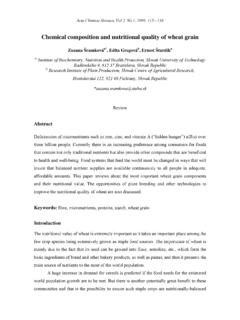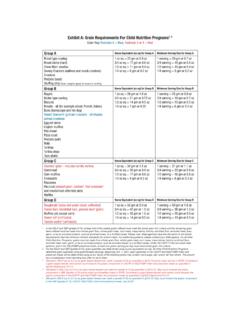Transcription of Wheat sector review - Egypt
1 Please address comments and inquiries to:Investment Centre DivisionFood and Agriculture Organization of the United Nations (FAO)Viale delle Terme di Caracalla 00153 Rome, Italy No. 21 September 2015 Egypt Wheat sector reviewReport No. 21 EgyptWheat sector reviewI4898E/1 and agriculture organization oF the united nationsrome, 2015egyptWheat sector reviewJulian McGill head of special Projects, lMc internationalDmitry Prikhodko economist, investment centre division, FaoBoris Sterkeconomist, investment centre division, FaoPeter Talkseconomist, investment centre division, Faocountry highlightsprepared under the Fao/eBrd cooperationThe designations employed and the presentation of material in this information product do not imply the expression of any opinion whatsoever on the part of the Food and Agriculture Organization of the United Nations (FAO) or the European Bank for Reconstruction and Development (EBRD) concerning the legal or development status of any country, territory, city or area or of its authorities, or concerning the delimitation of its frontiers or boundaries.
2 The mention of specific companies or products of manufacturers, whether or not these have been patented, does not imply that these have been endorsed or recommended by FAO or EBRD in preference to others of a similar nature that are not views expressed in this information product are those of the author(s) and do not necessarily reflect the views or policies of FAO or EBRD. FAO 2015 FAO encourages the use, reproduction and dissemination of material in this information product. Except where otherwise indicated, material may be copied, downloaded and printed for private study, research and teaching purposes, or for use in non-commercial products or services, provided that appropriate acknowledgement of FAO as the source and copyright holder is given and that FAO s endorsement of users views, products or services is not implied in any requests for translation and adaptation rights, and for resale and other commercial use rights should be made via or addressed to FAO information products are available on the FAO website ( publications) and can be purchased through photo: Mohamed El Khamisy | OF CONTENTSF oreword vacknowledgements viiacronyms and abbreviations ixexecutive summary xiPart I.
3 Towards a more active engagement of the private sector in the Egyptian grain sector xiPart II. The key aspects of the Egyptian Wheat supply chain xvi1 introduction 1 The grain sector 1 Wheat value chain 3 Potential for public private partnership 82 Wheat production 11 Overview 11 Egyptian agriculture 11 Shifts in crops 16 Wheat production costs 16 Gross margins 193 Wheat consumption 23 Overview 23 Major trends 24 Prospects 29 Wheat consumption and health 314 Wheat trade and storage 35 Wheat flows 35 Storage costs 455 Wheat milling and bread production 53 Types of flour 53 Milling margins 58 Bread baking 60iv6 Wheat policy 65 Introduction
4 65 Input subsidies 67 Output subsidies 70 Consumer support 72 Public investment in storage 74 State trading: complexity of tender documentation 76annex 1 consumption trends 81vFOrEwOrdEgypt the most populous country in the Arab World is also by far the largest importer of Wheat globally. For centuries, Wheat has been a central component of the typical diet of the country s inhabitants. Per capita consumption of this cereal is amongst the highest in the world. The domestic Wheat industry provides an important contribution to employment and value added in the agrifood sector . At the same time, assuring access to this important staple food by all Egyptian citizens, a quarter of whom live under the poverty line, has also been a central aspect of the country s social policies. The strategic importance of the Wheat sector has resulted in a strong involvement of the State at all levels of the Wheat value chain.
5 The joint sector review of the Food and Agriculture Organization of the United Nations (FAO) and the European Bank for Reconstruction and Development (EBRD) aims at helping both policy-makers and investors to achieve the goal of more efficient and inclusive agricultural and food systems. This publication was financed by the FAO and EBRD Multi-Donor Account for the Southern and Eastern Mediterranean (SEMED region). Its objective was to identify the main bottlenecks in the Wheat supply chain and to enable dialogue between Egyptian public and private sector actors in order to allow for greater private sector investment along the Wheat supply chain and ultimately improve the country s food security. The report provides a general overview of the Egyptian grain sector , followed by an analysis of more specific aspects of the Wheat sector such as production, consumption, trade, storage, milling and Wheat policy. The analysis lays particular stress on some of the weaknesses of the sector that should be addressed to make it more efficient.
6 In particular, the report underlines the importance of allowing for a more active participation of the private sector in assuring the country s food security. This would allow for an overall rationalization of the sector that could lead to important savings of public MerinoDirectorInvestment Centre Division, FAOA bdessalam Ould AhmedAssistant Director General and Regional RepresentativeFAO Regional Office for Near East and North AfricaGilles MettetalDirectorAgribusiness,EBRDviiACkN OwLEdgEmENTSThis study was co-financed by the FAO and EBRD Multi-Donor Account for the SEMED region, supported by Australia, Finland, France, Germany, Italy, the Netherlands, Norway, Sweden, Taipei China and the United Kingdom. The team of authors worked under the overall guidance of Dmitry Prikhodko, Economist, Investment Centre Division, FAO. Iride Ceccacci, Food Security Economist, EBRD and Philippe Erian, Principal Banker, Agribusiness, EBRD Egypt , coordinated the study on EBRD s side.
7 The main author of the report is Julian McGill from LMC International, United Kingdom. Peter Talks and Boris Sterk, both Economists at the FAO Investment Centre Division, conducted research on Wheat consumption and Wheat policy and contributed to the drafting of several chapters of the report. Oleksandra Prokopenko, Econometrician, contributed to the analysis and the chapter on Wheat consumption in Egypt . The authors used information collected from public and private sector sources in Egypt , as well as from the FAO country office. The authors are especially grateful to Dr Abd el Wahab Ismail Allam, Chairman at the Sugar Crops Council, whose help and insights were invaluable for the production of this report, as well as to Mr Abdolreza Abbassian, Senior Economist and Ms Monika Tothova, Economist at the FAO Trade and Markets Division, for their useful comments and thanks are also extended to Eng Mohamed Alaa El-Deen, Director-General, Storage and Niveen Salah, Assistant Director-General, Storage, Principal Bank of Development and Agricultural Credit (PBDAC); Dr Saleh Ahmed El Mofty, Economic Consultant, General Authority for Supply Commodities (GASC); Noura Abdelwahab, Programme Officer, World Food Programme (WFP); and Dr Mohamed El Ansary, Assistant FAO Representative of FAO in Egypt .
8 In the private sector , special thanks are extended to Brendon de Boer, Commercial General Manager, Cargill; Salah Tawfik, CEO, Sadri Mathari, Trading Manager and Sherif Abdel Ghaffar, MedSofts; Amr Kassem, Owner and General Manager, East Med Trading; Hesham Maksoud, General Manager and Kerim Barsoum, Marketing Manager, Louis Dreyfus Commodities; Hesham Hassanein, Regional Marketing and Special Projects Manager, US Wheat Associates; Sami Y Salahedin, Regional Director, CIMBRIA Egypt ; as well as other representatives of companies and industry associations for their time and the information shared with the authors would also like to thank Mr Khaled Hanafy, Minister for Supply and Internal Trade, for the open discussion and comments provided in a number of ANd ABBrEviATiONSCAPMAS Central Agency for Public Mobilization and StatisticsCAPQ Central Administration for Plant QuarantineCBOT Chicago Board of TradeEGP Egyptian poundEHCSS Egyptian Holding Company for Silos and StorageERSAP Economic Reform and Structural Adjustment ProgrammeFAO Food and Agriculture OrganizationFAOSTAT Food and Agriculture Organization of the United Nations Statistics DivisionFIHC Food Industries Holding CompanyGASC General Authority for Supply CommoditiesGCSS General Company for Silos and StorageGDP Gross domestic productGOEIC General Authority for Export and Import ControlIRR Internal rate of returnLHS Left-hand sideLMC LMC InternationalMALR Ministry of Agriculture and Land ReclamationMoSIT Ministry of Supply and Internal TradeNPV Net present valueOECD Organisation for Economic Cooperation and DevelopmentOPEC Organization of the Petroleum Exporting
9 CountriesPBDAC Principal Bank of Development and Agricultural Credit RHS Right-hand sideUSD United States dollarWHO World Health OrganizationArabic expressionsArdeb Traditional unit for measuring the volume of crops. One ardeb of Wheat is meant to weigh 150 Subsidized flat bread made from coarse 82 percent Egyptian clover, a high-yielding legume crop with low input requirements grown during the winter period and used as animal A traditional Egyptian measure of area. One feddan is Non-subsidized bread from finer 72 percent A short second summer crop grown from August until October (named after the period in which the Nile used to flood).Piastre One-hundredth of an Egyptian Large traditional flat storage system for Egyptian - Wheat sector reviewxiExECuTivE SummAryPart I. Towards a more active engagement of the private sector in the Egyptian grain sectorThe importance of Wheat for EgyptWheat is the most important grain crop in Egypt and grains are, in turn, the most important crop group.
10 Wheat represents almost 10 percent of the total value of agricultural production and about 20 percent of all agricultural imports. Egypt is also the world s biggest Wheat importer and the General Authority for Supply Commodities (GASC) of the Ministry of Supply and Internal Trade of Egypt (MoSIT) alone is the world s biggest Wheat purchaser. It is thus understandable that Wheat is a product of paramount importance to Egypt and Wheat policy is a priority for the importance of Wheat policy is reinforced by Egypt s specific social realities: with over a quarter of the Egyptian population living under the poverty line, assuring the food security of all citizens is a key challenge for the government. A key component of government policy in this regard is the provision of low-priced bread to the population. This is achieved through a number of government subsidies at the various stages of the value chain: from subsidized fertilizers to subsidies of the price of the final product, baladi bread.
















